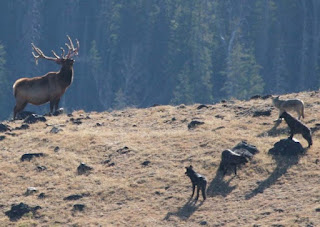Wolves and the Yellowstone Ecosystem
We hear about animals being territorial, guarding against intruders and generally keeping to their own areas. Wolves are like this instead of spreading out and being concentrated in single areas. In fact, most seem to respect the borders that they and their neighbors have marked.
In Yellowstone National Park, the last wolf pack was killed in the 1920s, and over the years, the elk population got a mite uppity. Several cascading effects happened. Elks over-grazed which led to erosion. Officials decided to bring in wolves.
 |
| Yellowstone wolves and elk, National Park Service / Doug Smith |
Wolves are apex predators. This means that they are top of their food chain, and normally only have to fear man, and possibly each other. Yet, it was not so in the beginning, when all animals lived in harmony with each other and mankind. Diets were vegetarian and all was very good (Genesis 1:29–31).
. . .
The creation account of Genesis 1 distinguishes between aquatic and terrestrial creatures (with some having flight and/or swim capacity). But do they all roam free or are there restrictions to their whereabouts?
The full article is found at "Wandering wolves."